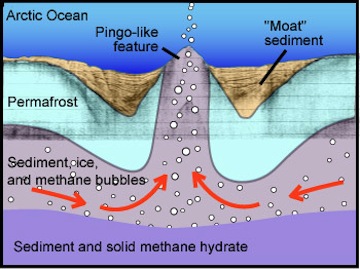350815-methane bubbles.jpg

Methane bubbles deep in the ocean floor can seep to the surface. Credit: (c) 2007 MBARI (Monterey Bay Aquarium Research Institute)
The ocean floor sometimes “burps.” In fact, according to some recent research, it burps a lot just off the eastern coast of the United States.
For two years, researchers used sonar to peer at the continental margin from Massachusetts down to North Carolina. That margin is where the shallow continental shelf gives way to the deep ocean.
The sonar revealed columns of bubbles streaming from 570 spots along the margin. The researchers haven’t sampled the gas in those bubbles, but it most likely consists of methane — the main ingredient in natural gas.
Billions of tons of methane are locked up at the ocean floor in gas hydrates -- a mixture of methane and frozen water.
If scientists and engineers can develop the right technology, the slushy mixture could someday provide an abundant energy resource. But it could also speed up global warming. That’s because methane is a strong greenhouse gas — it traps energy from the Sun, making our planet warmer. Rising temperatures at the ocean floor could melt some of the gas hydrates, releasing methane into the water and, eventually, into the air.
It’s possible that some of the bubbles off the American coast are being released as a result of global warming. But the researchers found that at least some of the gas vents appear to have been active for more than a thousand years.
And so far, the bubbles aren’t making it into the atmosphere. Instead, they’re reacting with sea water to produce carbon dioxide — the fizzy gas in soft drinks that makes you burp.

